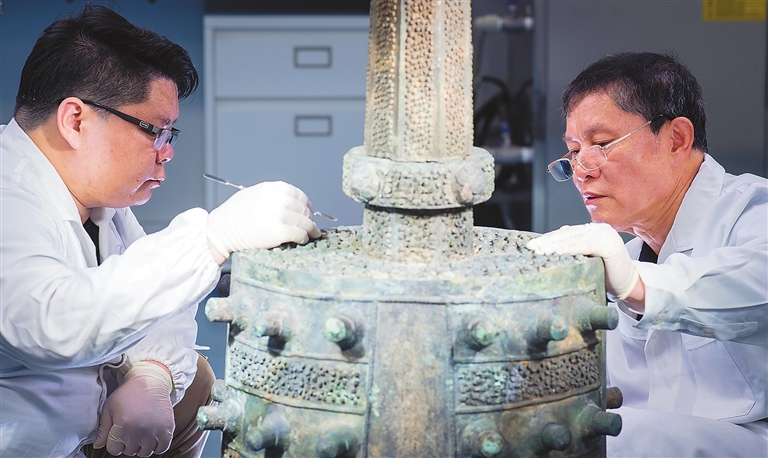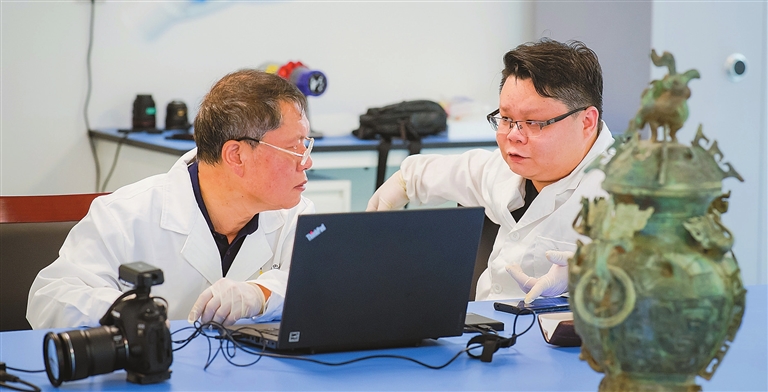

FIVE years ago, a documentary series titled “Masters in Forbidden City” was released in China and soon became a hot-button topic on social media, bringing the profession of cultural relic restoration into the public spotlight. Given China’s long history and rich collections of ancient artifacts from various dynasties, it takes meticulous hands, years of experience and a thorough understanding of history to become a qualified restorer. As backstage heroes, many of them have dedicated their lives to preserving national treasures. Inside the Hubei Provincial Museum in Wuhan, Fang Guorong, 62, and Fang Chen, 32, jointly lifted a 12-kg bronze object in an attempt to restore a huge and ancient bian zhong, or chime bell. The Fangs, father and son, both work as relic restorers at the museum. The 150-kg chime bell they were taking care of is the biggest and heaviest one preserved here, having been unearthed from a 2,500-year-old tomb in Suizhou, Hubei, in 2009. Chime bells are a percussion instrument that became prevalent in China from the Western Zhou Dynasty (1046-771 B.C.). The country’s largest set of chime bells ever unearthed was found in 1978, also in Suizhou, in the tomb of Marquis Yi, a ruler of the ancient Zeng State. The set of 65 chime bells has been a key collection of the museum. Fang Guorong has been engaged in the restoration of bronzeware for more than 40 years, since he became a staff member of the museum. He has participated in various chime-bell restoration projects and has served as the technical director in various duplicate projects. The process of chime bell restoration — including designing, wax mold-making, investment casting, welding, polishing and antique finishing — demands both skill and patience. Fang Guorong enjoys it, cherishing every touch of the bells as part of a dialogue with craftsmen of the distant past. According to Fang, some of the chime bells rescued in the 2009 excavation were deemed too broken to be restored, including the heaviest one. Fortunately, in recent years, digital technologies have been applied effectively to the restoration of relics, saving more artifacts. “3D scanning and 3D printing are being used to restore the severely damaged and deformed cultural relics. This is something the older generation of cultural relic protection workers couldn’t even dream of,” he said. “These are the advantages that the younger generation has.” Fang Chen joined the museum in 2014. He has received strict training from masters like his father and acquired new technologies that his predecessors may have found challenging. “The restoration work should also keep pace with the advances in technology,” said the son. “This doesn’t mean overturning the traditional methods. It is about combining old and new methods to better protect and restore cultural relics.” While some restorers, like the Fangs, deal with heavy objects such as bronzeware, others are good at fixing things as light as a piece of paper. For around four decades, a desk lamp, a plate of adhesive paste, and a brush have constituted the basic equipment of Wang Jinyu’s daily work. Wang, 59, is an ancient book restorer at the Tianyige Museum in the city of Ningbo, in East China’s Zhejiang Province. Tianyige is the most ancient private library in China, built in the 1500s, preserving over 300,000 volumes of ancient books. Many of the books need careful maintenance or repair due to aging, being moth-eaten, cracking and other damage. Restoration starts with selecting the right paper. The museum offers nearly 300 types of paper of different colors, thicknesses and textures, and a restorer has to find the one most similar to that of the original book. After disassembling, dusting and flattening the pages to be fixed, the restorer tears a patch from the selected paper, dips it in paste and carefully sticks it to the back of the page to cover the hole. Then any extra material is trimmed bit by bit until the page is restored. The process may sound simple, but it is time-consuming in practice. In Wang’s opinion, a qualified restorer has to be calm, careful, patient and perseverant. “We would sit there for hours just to cover a tiny hole,” she said. (Xinhua) | 
